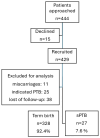Low Levels of Complement Factor H in the First Trimester of Pregnancy Are Associated with Spontaneous Preterm Birth
- PMID: 39408876
- PMCID: PMC11476428
- DOI: 10.3390/ijms251910549
Low Levels of Complement Factor H in the First Trimester of Pregnancy Are Associated with Spontaneous Preterm Birth
Abstract
Preterm birth (PTB) remains a significant public health concern, and prediction is an important objective, particularly in the early stages of pregnancy. Many studies have relied on cervical characteristics in the mid-trimester, with limited results. It is therefore crucial to identify novel biomarkers to enhance the ability to identify women at risk. The complement pathway is implicated in the process of placentation, and recent proteomics studies have highlighted the potential roles of some complement proteins in the pathophysiology of PTB. To determine the association between the occurrence of spontaneous preterm birth (sPTB) and the concentration of complement C3, factor B, and factor H in the blood of pregnant women during the first trimester. This prospective cohort study included women with singleton pregnancies, both with and without a history of sPTB, from two health institutions in Bucaramanga, Colombia. The outcome was sPTB before 37 weeks. A blood sample was obtained between 11 + 0 to 13 + 6 weeks. ELISA immunoassay was performed to quantify the levels of C3, factor B, and factor H. A total of 355 patients were analyzed, with a rate of sPTB of 7.6% (27/355). The median plasma concentration for C3, factor B, and factor H were 488.3 μg/mL, 352.6 μg/mL, and 413.2 μg/mL, respectively. The median concentration of factor H was found to be significantly lower in patients who delivered preterm compared to patients who delivered at term (382 μg/mL vs. 415 μg/mL; p = 0.034). This study identified a significant association between low first-trimester levels of factor H and sPTB before 37 weeks. These results provide relevant information about a new possible early biomarker for sPTB. However, the results must be confirmed in different settings, and the predictive value must be examined.
Keywords: C3; Factor B; alternative complement pathway; biomarker; factor H and preterm birth.
Conflict of interest statement
The authors declare no conflicts of interest. The funders had no role in the design of the study, in the collection, analyses, or interpretation of data, in the writing of the manuscript, or in the decision to publish the results.
Figures
Similar articles
-
Prediction of spontaneous preterm birth and preterm prelabor rupture of membranes using maternal factors, obstetric history and biomarkers of placental function at 11-13 weeks.Ultrasound Obstet Gynecol. 2022 Aug;60(2):192-199. doi: 10.1002/uog.24917. Epub 2022 Jul 8. Ultrasound Obstet Gynecol. 2022. PMID: 35445767
-
Routine first-trimester pre-eclampsia screening and risk of preterm birth.Ultrasound Obstet Gynecol. 2022 Aug;60(2):185-191. doi: 10.1002/uog.24915. Epub 2022 Jun 22. Ultrasound Obstet Gynecol. 2022. PMID: 35441764 Free PMC article.
-
The predictive value of maternal serum AFP to PAPP-A or b-hCG ratios in spontaneous preterm birth.J Obstet Gynaecol. 2022 Aug;42(6):1956-1961. doi: 10.1080/01443615.2022.2055452. Epub 2022 May 27. J Obstet Gynaecol. 2022. PMID: 35620869
-
Early prediction of spontaneous preterm birth before 34 gestational weeks based on a combination of inflammation-associated plasma proteins.Front Immunol. 2024 Jul 15;15:1415016. doi: 10.3389/fimmu.2024.1415016. eCollection 2024. Front Immunol. 2024. PMID: 39076980 Free PMC article.
-
Risk of spontaneous preterm birth in singleton pregnancies conceived after IVF/ICSI treatment: meta-analysis of cohort studies.Ultrasound Obstet Gynecol. 2018 Jan;51(1):43-53. doi: 10.1002/uog.18930. Ultrasound Obstet Gynecol. 2018. PMID: 29114987 Review.
References
-
- Ohuma E.O., Moller A.B., Bradley E., Chakwera S., Hussain-Alkhateeb L., Lewin A., Okwaraji Y.B., Mahanani W.R., Johansson E.W., Lavin T., et al. National, regional, and global estimates of preterm birth in 2020, with trends from 2010: A systematic analysis. Lancet. 2023;402:1261–1271. doi: 10.1016/S0140-6736(23)00878-4. - DOI - PubMed
-
- [(accessed on 27 September 2024)]; Available online: https://www.dane.gov.co/index.php/estadisticas-por-tema/demografia-y-pob....
-
- Liu L., Oza S., Hogan D., Chu Y., Perin J., Zhu J., Lawn J.E., Cousens S., Mathers C., Black R.E. Global, regional, and national causes of under-5 mortality in 2000–15: An updated systematic analysis with implications for the Sustainable Development Goals. Lancet. 2016;388:3027–3035. doi: 10.1016/S0140-6736(16)31593-8. Correction in Lancet 2017, 389, 1884. - DOI - PMC - PubMed
MeSH terms
Substances
Grants and funding
LinkOut - more resources
Full Text Sources
Miscellaneous



